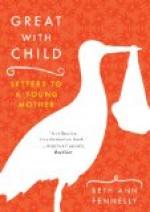They are moreover exceedingly fond of display. Some mothers seem to act—in all they do with and for children—as if all the latter were good for, was display and amusement. They feed them, indeed, and strive to prolong their existence; but it appears to be for similar reasons to those which would lead them to take kind care of a pet lamb.
It is on this account that they dress them out in the manner they do, strive to make them sit up straight, and prohibit their creeping. It is on this account too, as much perhaps as any other, that go-carts and leading strings are put in such early requisition. The contrary would be far the safer extreme; and the parent who keeps his child scrambling about upon the back as long as possible, and when he cannot prevent longer an inversion of this position, retains him at creeping as long as is in his power, is as much wiser, in comparison with him who urges him forward to make a prodigy of him, as he is who, instead of making his child a prodigy in mind or morals at premature age, holds him back, and endeavors to have his mental and moral nature developed no faster than his physical frame.
I wish young mothers would settle it in their minds at once, that the longer their children creep the better. They need have no fears that the force of habit will retain them on their knees after nature has given them strength to rise and walk; for their incessant activity and incontrollable restlessness will be sure to rouse them as early as it ought. Least of all ought the difficulty of keeping them clean, to move them from the path of duty.
Children who are allowed to crawl, will soon be anxious to do more. We shall presently see them taking hold of a chair or a table, and endeavoring to raise themselves up by it. If they fail in a dozen attempts, they do not give up the point; but persevere till their efforts are crowned with success.
Having succeeded in raising themselves from the floor, they soon learn to stand, by holding to the object by which they have raised themselves. Soon, they acquire the art of standing without holding; [Footnote: The art of standing, which consists in balancing one’s self, by means of the muscles of the body and lower limb—simple as it may seem to those who have never reflected on the subject—is really an important acquisition for a child of twelve or fifteen months. No wonder they feel a conscious pride, when they find themselves able to stand erect, like the world around them.] ere long they venture to put forward one foot—they then repeat the effort and walk a little, holding at the same time by a chair; and lastly they acquire, with joy to them inexpressible and to us inconceivable, the art of “trudging” alone.
When children learn to walk in nature’s own way, it is seldom indeed that we find them with curved legs, or crooked or clubbed feet. These deformities are almost universally owing either to the mother or the nurse.




